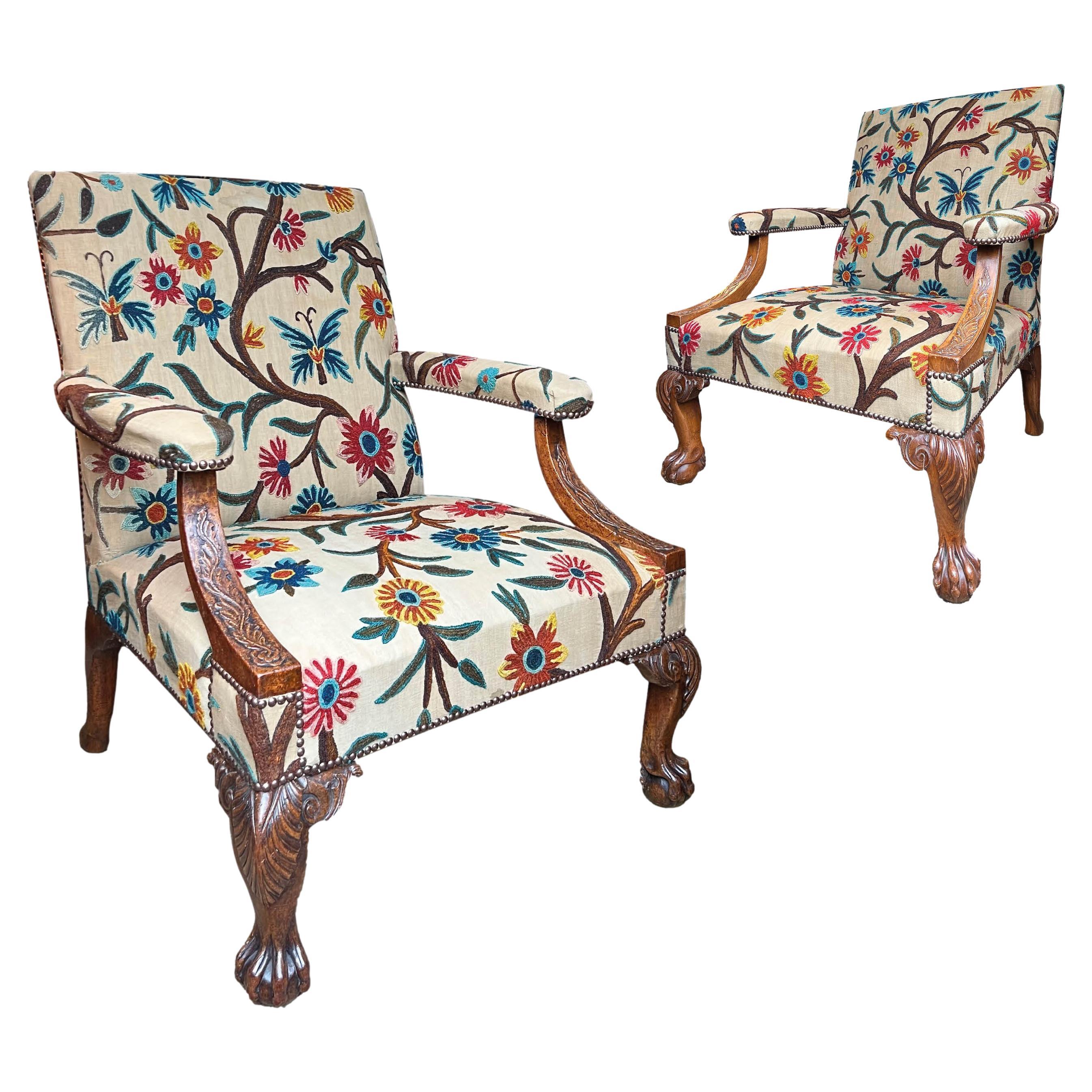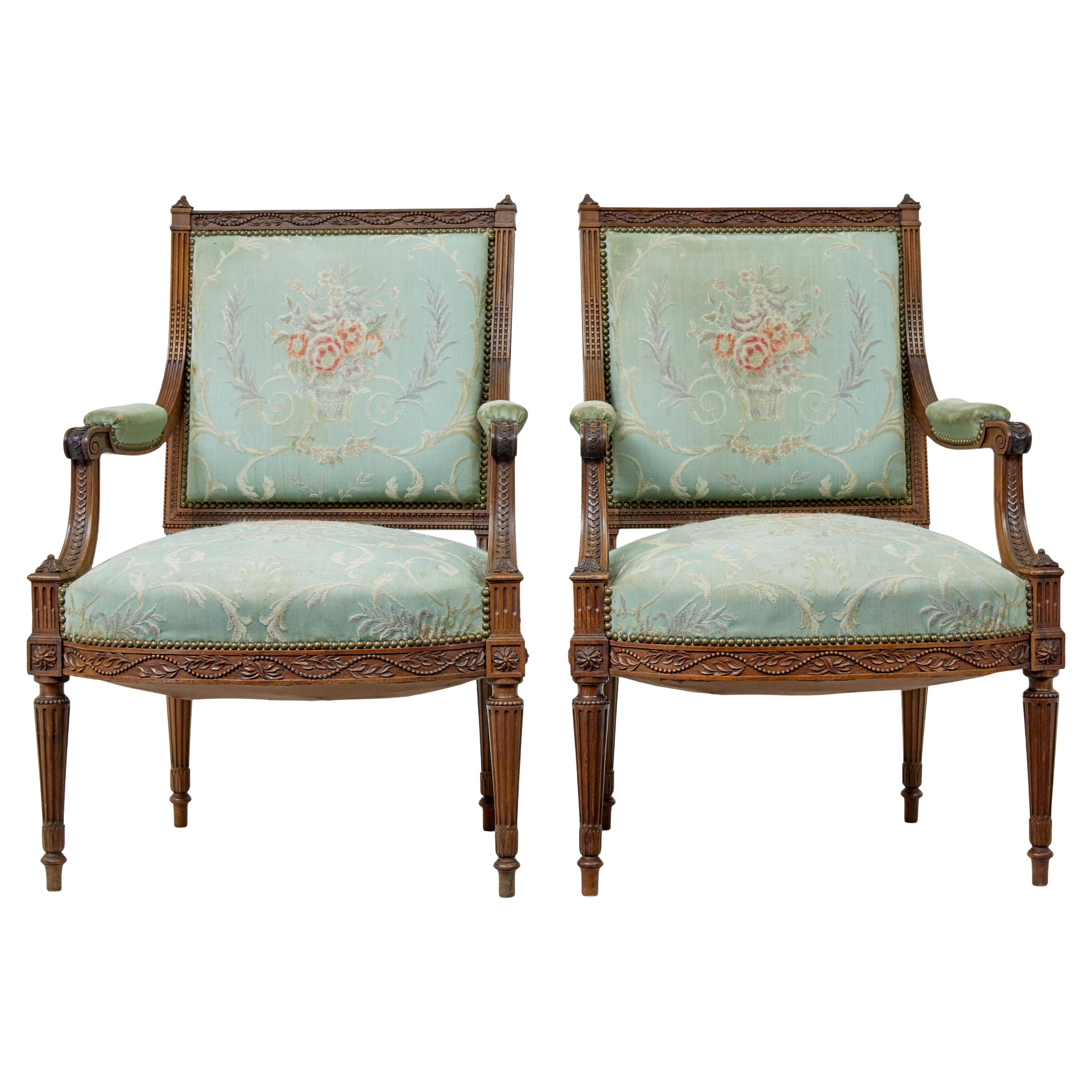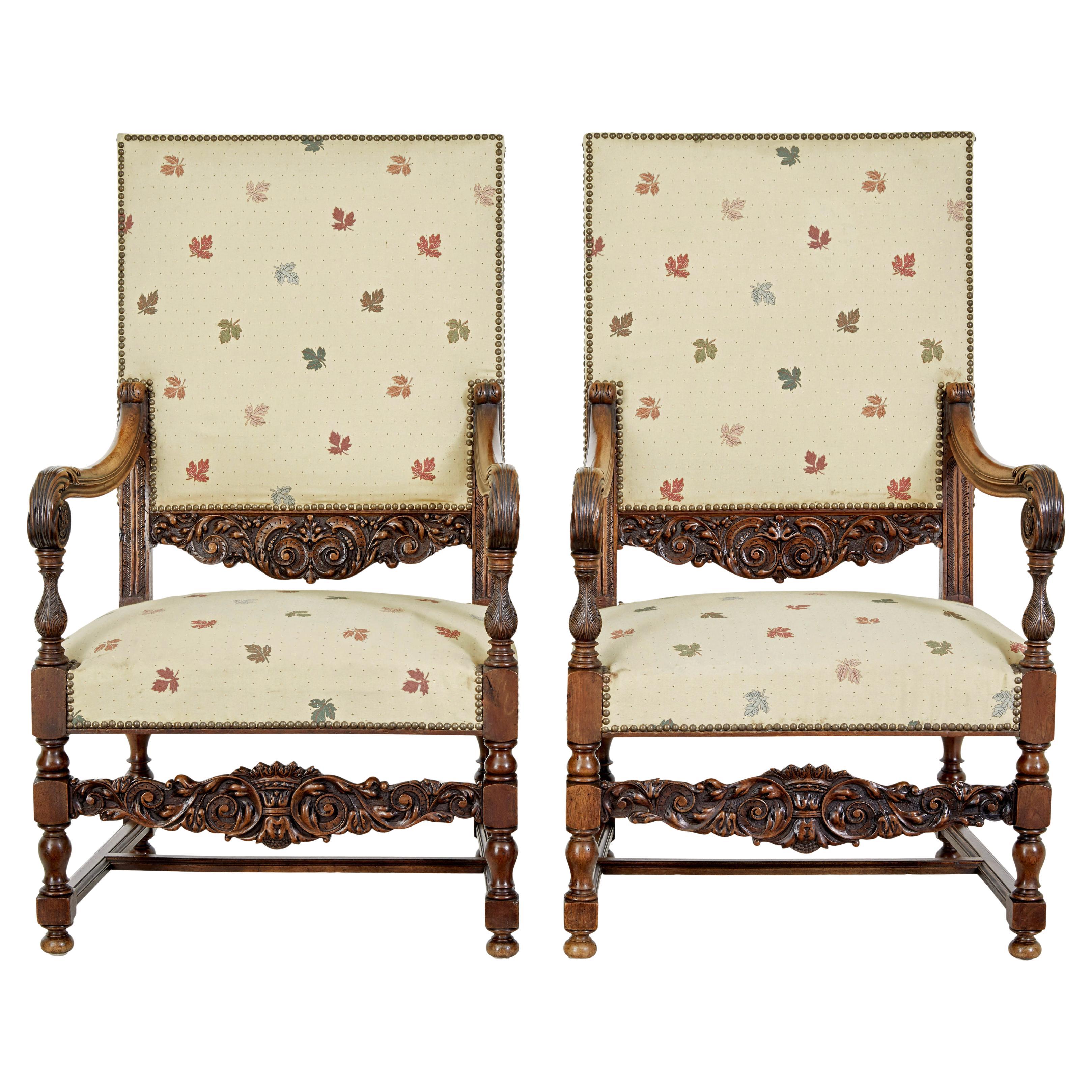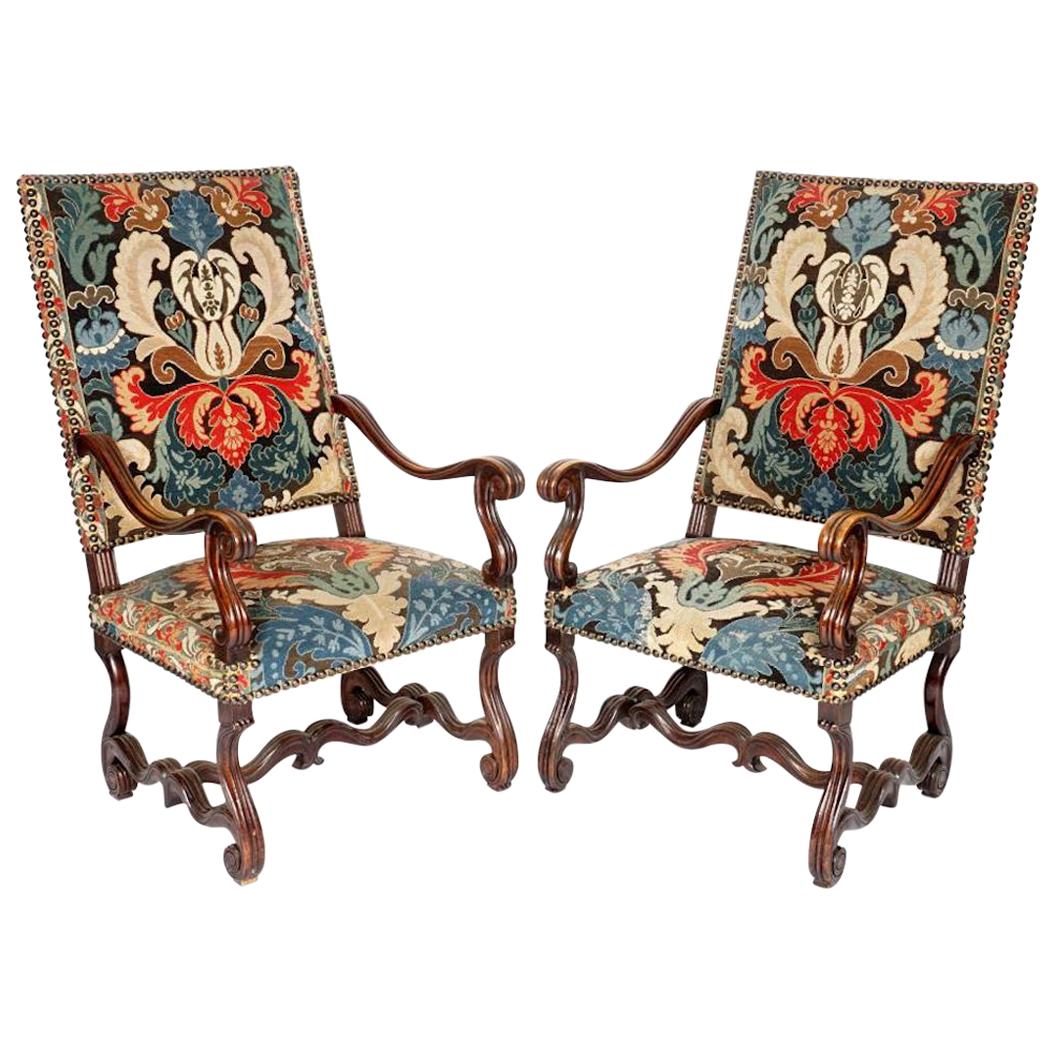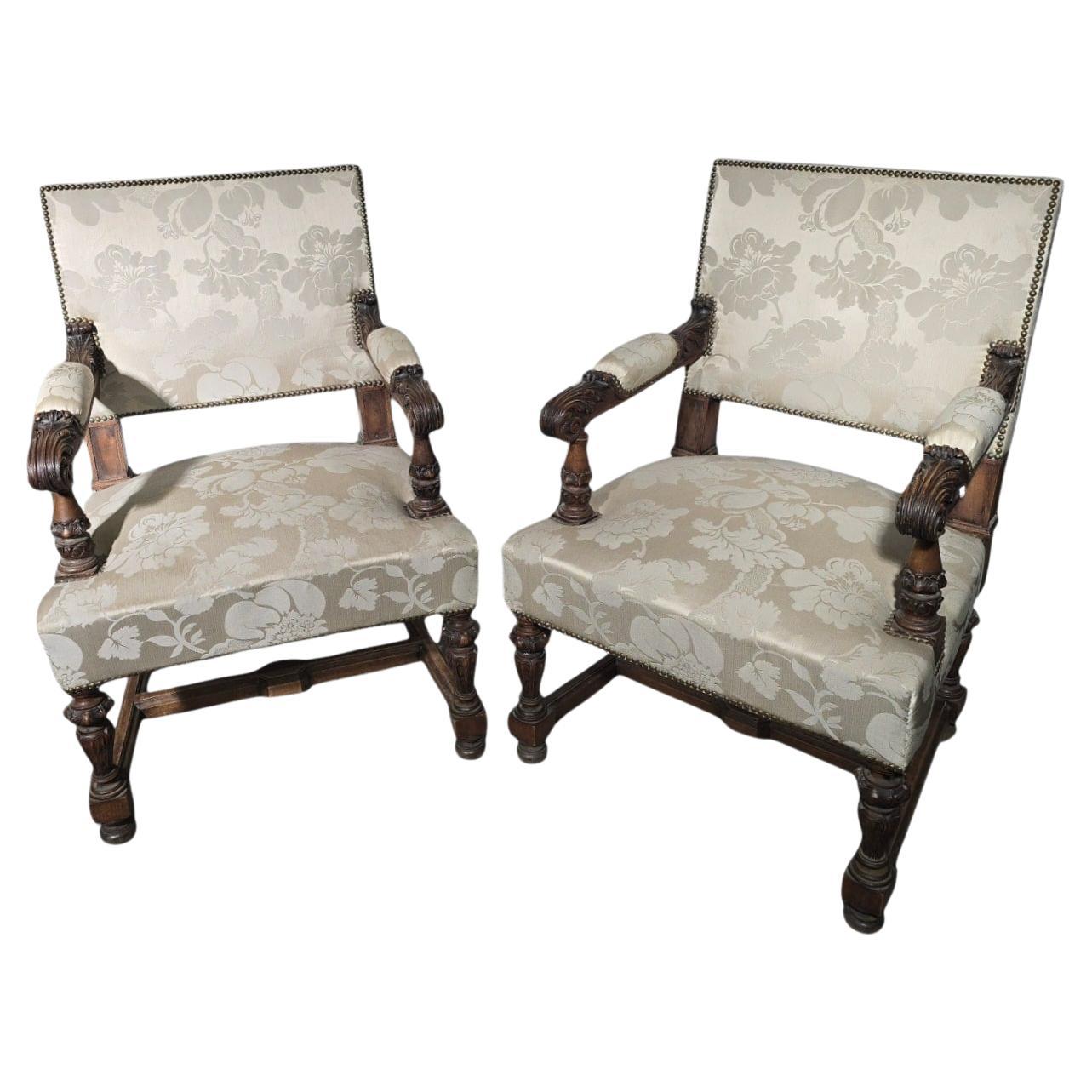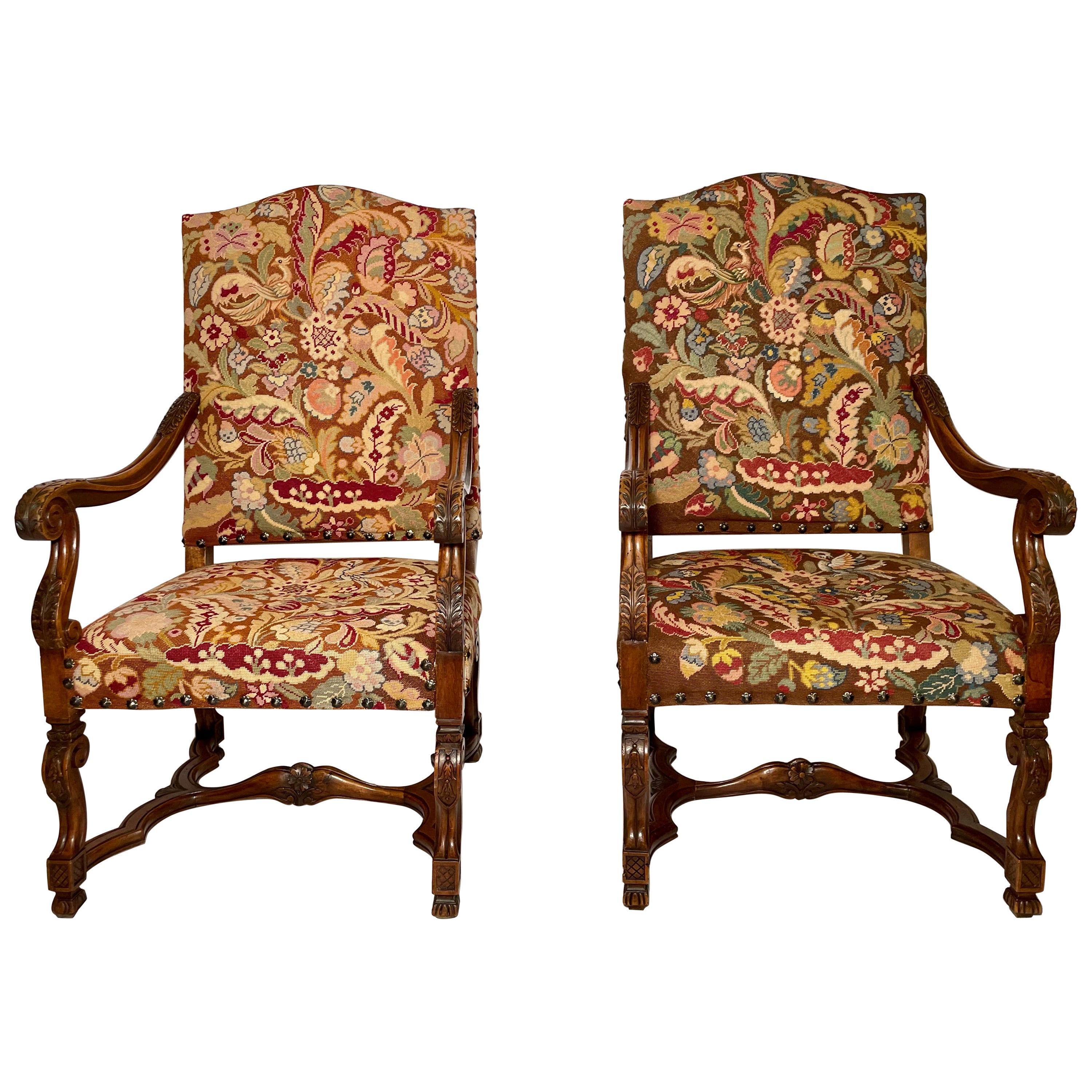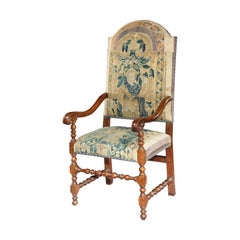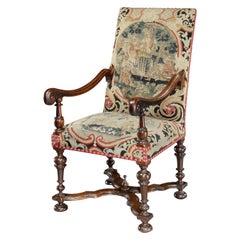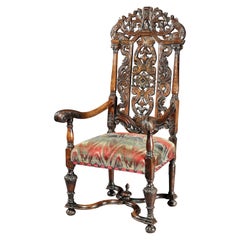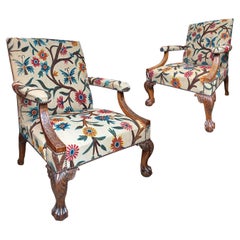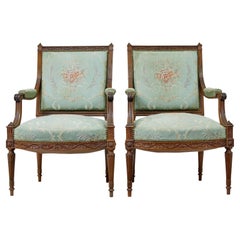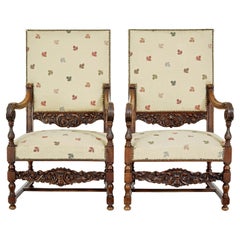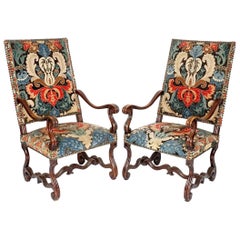Items Similar to Pair of Walnut Armchairs, Late 16th Century, French Renaissance, with Ram Mask C
Want more images or videos?
Request additional images or videos from the seller
1 of 21
Pair of Walnut Armchairs, Late 16th Century, French Renaissance, with Ram Mask C
$21,031.25
£15,000
€17,822.40
CA$28,701.61
A$31,961.84
CHF 16,634.37
MX$394,085.59
NOK 211,851.42
SEK 199,119.80
DKK 132,977.24
Shipping
Retrieving quote...The 1stDibs Promise:
Authenticity Guarantee,
Money-Back Guarantee,
24-Hour Cancellation
About the Item
"This rare pair of upholstered open armchairs relate to examples in museum collections in France, the USA and the UK. Few pieces of Renaissance furniture featuring ram’s head motif arm terminals survive as the chairs would have been in the ownership of the elite symbolising leadership and authority. The condition of these armchairs reflects their age and use and they have a rich colour and lustrous patina.
The form of these chairs is characteristic of a stereotypical Renaissance model. The upholstered section of the backs are upholstered in wool with applied 17th century floral needlework faced with gilded studs and supported by square section uprights. The channelled tablet and stylised rosette incised curved arms terminate in acanthus capped carved rams' masks and are supported by column turned uprights headed by an entrelac collar. The ram is a symbol of leadership and authority and it also determination, action, initiative, and Aries, the first sign of the Zodiac. The seats are upholstered in wool with applied 17th century needlework faced with gilded studs and supported by tapering column/ring turned front legs and square section back legs. Some of the stretchers with moulded detailing. Standing on front ball feet. Exceptional original colour and patina. Henri II 1550-60.
Condition: The chairs are both sturdy with exceptional colour and patina. One armchair with a splice on the rhs back leg and replaced but period front and lhs stretcher both bearing old nail marks, two other replaced stretchers and the back uprights bearing old nail marks indicating that they were upholstered at some point. The other armchair with an old repair to a break in the right back leg and an old patch near the end of the leg, replaced but period back and lhs stretcher, small patch to bottom of lhs arm where it meets the support. Old worm marks and some losses. Considering the age of the armchairs, these repairs and replacements are not unusual and consistent with the repairs on the related armchairs in museum collections. They suggest that the chairs either fell backwards at some point or someone leant back while sitting in them.
Back Height 107cm, 42in, Seat Height 59.5cm, 23½in
Width 60cm, 23½ in, Seat 59cm, 23¼in
Depth including arm 59cm, 23¼in, Seat 49cm, 19¼in
Provenance: Deaccessioned by The National Galleries of Scotland
Bearing an old transport label from Alain Moatti (French architect) to Mrs Katz, London
Literature: Related to :
There are comparable armchairs in international museum collections dated to the second half of the 16th century. Most share the following characteristics with the above pair, the form, the ram's mask carved to the end of each arm, the curvilinear outline of the arm rests, the ring turned front legs as well as the plain square section back legs and plain stretchers.
1. Two stained glass windows at Cothele demonstrate early use of the ram’s head motif in England
a. Date circa 1493 - circa 1520
b. NT 348896 . 3 & NT 348896 . 4
2. The Frick Collection, Upholstered Armchair with Ram's-Head Terminals, French, Sixteenth Century, Accession number: 1916 . 5 . 89, illustrated in D . Dubon and T. Dell, Furniture in the Frick Collection, Vol. V, 1992, New York, pp's 178-83 .
a. Date: 16th and 19th century
b. Medium: Walnut, pine, ebony and other wood, upholstered with velvet, braid and fringe
c. Dimensions: 41 x 21 5/8 x 23 1/4 in. (104.1 x 54.9 x 59.1 cm)
d. Credit Line: Henry Clay Frick Bequest
3. Frick Collection, Upholstered Armchair with Ram's-Head Terminals, French, Sixteenth Century, illustrated in D. Dubon and T. Dell, Furniture in the Frick Collection, Vol. V, 1992, New York, pp's 178-83 .
a. Accession number: 1965. 5. 152
b. Date: 16th and 19th century
c. Dimensions: 41 1/2 × 20 5/8 × 23 1/4 in . (105.4 × 52.4 × 59.1 cm)
d. Credit Line: Bequest of Childs Frick, 1965
4. Cinquantenaire museum, Brussels, Collection Sculptures and Furniture,
a. Inventory number 3147
b. Armchair, Chaise de commode
c. Date : France, Date 1501 / 1550
d. Walnut, leather, velvet
e. Dimensions : Height: 130 cm, Width: 57,5 cm, Depth: 51 cm
f. Owner : Musées royaux d'art et d'histoire/Koninklijke Musea voor Kunst en Geschiedenis
g. Requested image 10/01/19
5. Musee du Louvre, Caquetoire, don Davillie, noyer, illustrated in Jacques Thirion p144
a. 2e moitie du XVI siecle
b. OA 3120)
6. Museum fur Kunsthandwert, Francfort-sur Main, Caquetoire, noyer, illustrated in Jacques Thirion p 144
a. 2 e moitie du XVI siècle
7. Pair of chairs with a Chilham Castle provenance
a. Offered by Galerie Liova – Marc Perpitch in 2014
b. Image requested
8. The Musee des Arts Decoratifs
a. Inventory Number PE 1225
b. Date : described as 1575-1600 on the label
c. Lacks the tetes de belier
d. Requested image
9. V&A Museum
a. Armchair
b. France (made)
c. Date: late 16th century (made)
d. Walnut, carved and turned
e. Museum number
f. Dimensions
g. Height: 110 . 5 cm, Width: 57 . 5 cm, Depth: 50 cm
10. Le château d'Écouen, Musee National de la Renaissance
a. Similar, also without upholstery, and with a different style of carved back.
b. Requested image
11. Le Mobilier Francais du Moyen Age a la Renaissance, Jaqueline Boccador
a. “Certaines de ces chaires a bras de plus grand raffinement et devenue tres rare sont dites a ‘tetes de beliers’. En effet, les bouts d’accotoirs ou nez sont sculptes dans le prolongement de celui-ci et toujours dans le meme morceau de bois, de tetes de belier, le plus souvent de grande qualite”.
b. Boccador illustrates three related chairs 235, 236 238 from private collections
12. There will be other analogies in French regional collections, but it is not easy to locate them.
13. A pair of gesso and gilt open upholstered armchairs at Knole Park
a. Date circa 1672
b. NT 129527
14. The ram’s head motif more commonly found painted on shields on the backs of hall chairs:
a. Montacute House, long set of eighteen, circa 1720, NT 2900077
b. Seaton Delaval Hall, three chairs, circa 1720 NT 1276666
15. An open armchair at Nymans
a. Date circa 1880
b. NT1205843
16. The ram’s head is a carved or sculptured decoration found in Greek and Roman art
17. The ram’s head was revived as a decorative motive in the 18th century furniture and extensively used by Robert Adam in mask form in the 18th century
a. Three benches in the entrance hall at Osterley, unattributed, circa 1760, NT 771724
b. Candlestand ca. 1771-1774 (made) Adam, Robert, born 1728 - died 1792 (designer)
c. Materials and Techniques, VAM, W.36A-1946. Three designs for candelabra for the Eating Room of 20 St James's Square are included in Adam's volumes of designs, housed in the Soane Museum, London. Two of them (vol. 6, nos 53 and 54) are dated 26 April 1777 and inscribed for Sir Watkin Williams-Wynn. The third (vol. 6, no. 49) is neither dated nor inscribed but most closely resembles the executed object.
18. There was another revival of the ram’s head motif in the 19th century furniture inspired by neo-classical style
Literature
• D. Dubon and T. Dell, Furniture in the Frick Collection, Vol. V, 1992, New York.
• Jacques Thirion. Le Mobilier du Moyen Age et de la Renaissance en France, Editions Faton, 1998
• D. Dubon and T. Dell, Furniture in the Frick Collection, Vol. V, 1992, New York
• Jacqueline Boccador, Le Mobilier Francais du Moyen Age a la Renaissance, Editions d’Art, Monelle Hayot
Ram’s Head Symbolism In Antiquity
The Ram was revered by the Persians and sacred to the Egyptians as a symbol of life, dominion and stability. It is also said to represent leadership and authority. The symbolism of the Ram has great antiquity. The cult of the Ram flourished in the Middle East beginning about 2000 BC. For example, the chief god of Upper Egypt was Amon, a highly spiritual deity whose name means 'occult' or 'hidden.'He was originally represented as having the head of a Ram and was worshiped in Roman times as Jupiter Ammon. Isaiah prophesied that the Rams returning to Israel with God's scattered children would joyfully offer themselves upon the altars of the Millennial Temple. The most famous Ram in the Old Testament is the one Abraham found trapped by its horns in a thicket on Mount Moriah where he had gone to sacrifice his only son Isaac. [Gen 22: 1-14] An angel stopped the hand of Abraham just as he was about to kill his boy and the Ram was sacrificed instead. This story is known as the akedah (binding) and is a reminder of the obedience of the patriarchs.
In antiquity symbolic imagery of the ram was used to evoke power and strength, such as the c. 680 BC granite RAM OF AMUN-RE in the Ashmolean Museum (AN1931.553)
The ram was a powerful symbol throughout the ancient world. A ram head figurine was found in the Tsauni Mine in Nigeria. It dates to about 500 BC. The skins of rams dyed red made a covering for the Tent of Meeting (Ex. 26:14). This is the blood covering over Moses as he met with the Almighty.
The Golden Fleece of Chrysomallos, the ram who bore Phrixus to Colchis, where the ram was then sacrificed in accordance with Hermes’ love of flesh offerings and hung in a tree guarded by a fearsome serpent. There we meet hybrid beasts of bull headed men, lions with eagle or human heads and endless others who were common deities and demi-deities. The rampant sexuality of men and gods seen in both Classical Greek and Irish tales made for many bizarre offspring. Although Chrysomallos could not save Helle from her fate he did talk to Phrixus, which few rams do, and after his sacrificial death he was put into the heavens as the constellation Aries the ram
A Greek sculpture of a Ram with the Golden Fleece c. 300 B.C. now in the Römisch-Germanischer Museum, Köln. His mouth is open, as if to talk, just as Chrysomallos did in Colchis when it told Phrixus to sacrifice him to Zeus.
There are hidden ram’s heads in Michaelangelo’s ceiling in the Sistene Chapel which Dr Deivis de Campos, a researcher in human anatomy at the Federal University of Health Sciences in Porto Alegre in Brazil, and eight colleagues argue hid coded messages about pagan notions of female sexuality. “In the exact centre of the Sistine Chapel’s ceiling, Michalengelo may have placed a notorious pagan female symbol,” they posited in the paper, entitled “The hidden symbols of female anatomy in Michelangelo Buonarroti's ceiling in the Sistine Chapel.” The sweeping fresco features eight ram’s skulls, complete with horns, which the scholars believe are subversive representations of the female reproductive anatomy. They claim the ram’s skulls closely match a woman’s uterus and Fallopian tubes. The ram was revered in ancient Egypt in matters of fertility and war. Early gods with long wavy ram horns include Khnum and the equivalent god in Lower Egypt, Banebdjedet, the 'Ram Lord of Djedet' (Mendes), who was typically shown with four ram heads to represent the four souls (Ba) of the sun god. Banebdjedet may also be linked to the first four gods to rule over Egypt, Osiris, Geb, Shu and Ra-Atum, with large granite shrines devoted to each in the Mendes sanctuary. The Book of the Heavenly Cow describes the 'Ram of Mendes' as being the Ba of Osiris, but this was not an exclusive association."
- Dimensions:Height: 42.52 in (108 cm)Width: 24.41 in (62 cm)Depth: 24.81 in (63 cm)
- Style:Renaissance (Of the Period)
- Materials and Techniques:Walnut,Needlework
- Place of Origin:
- Period:
- Date of Manufacture:1550-1600
- Condition:
- Seller Location:BUNGAY, GB
- Reference Number:1stDibs: LU3867315797272
About the Seller
5.0
Vetted Professional Seller
Every seller passes strict standards for authenticity and reliability
Established in 1985
1stDibs seller since 2018
97 sales on 1stDibs
Typical response time: 9 hours
- ShippingRetrieving quote...Shipping from: BUNGAY, United Kingdom
- Return Policy
Authenticity Guarantee
In the unlikely event there’s an issue with an item’s authenticity, contact us within 1 year for a full refund. DetailsMoney-Back Guarantee
If your item is not as described, is damaged in transit, or does not arrive, contact us within 7 days for a full refund. Details24-Hour Cancellation
You have a 24-hour grace period in which to reconsider your purchase, with no questions asked.Vetted Professional Sellers
Our world-class sellers must adhere to strict standards for service and quality, maintaining the integrity of our listings.Price-Match Guarantee
If you find that a seller listed the same item for a lower price elsewhere, we’ll match it.Trusted Global Delivery
Our best-in-class carrier network provides specialized shipping options worldwide, including custom delivery.More From This Seller
View AllArmchairs, Pair, Flemish, 17th Century, Walnut, Upholstered, Bargello, Scrollarm
Located in BUNGAY, SUFFOLK
This pair of open armchairs are characteristic of the Haute Époque employing elegant barley-twist turnings and sweeping, curved, scroll arms. The bargello is a re-creation of a fashi...
Category
Antique 17th Century Dutch Baroque Armchairs
Materials
Walnut
Armchair, chair, 17th Century, Italian, Walnut, Scroll, Baroque, Tapestry
Located in BUNGAY, SUFFOLK
This elegant armchair exudes classic gravitas, with scroll arms, fall turnings and triple toe feet
The tapestry back depicting Flora underneath a bower is a distinctive feature. It...
Category
Antique 17th Century Italian Baroque Armchairs
Materials
Walnut
Armchair chair 17th Century English Walnut Needlework X-Stretchered, Scroll
Located in BUNGAY, SUFFOLK
An exceptional, museum quality, English, baroque, walnut, open armchair with faceted legs and shaped ‘x’ stretcher, upholstered in fine Georgian needlework...
Category
Antique 17th Century English Baroque Armchairs
Materials
Walnut
Armchair, Walnut, Carved, Upholstered, Daniel Marot, Flemish, 17 Century Baroque
Located in BUNGAY, SUFFOLK
A fine, large, late 17th century, Flemish, open armchair in the style of Daniel Marot with an upholstered seat
This fine, armchair is an, unusually, large size and the carving is of exceptional quality reflecting the status of the owner it was made for. It is sturdy and in usable condition. Chairs of this type, with tall, intricately carved backs, were placed in rows against a wall forming part of the decoration of a room. The carving of the back of this chair is French in style and was based on decorative prints by Daniël Marot
The cresting carved with a profusion of acanthus leaf scrolls. The back with fine, pierced carving. The mid-section with a central flowerhead with scrolled shields above and below ornamented with flowerheads acanthus leaf crestings. Two pairs of carved ‘S’ scrolls ornamented with acanthus leaves either side. The tapering turned sections surmounted by ionic capitals and supporting back of the scroll arms carved with acanthus leaf ornament. The front arms supported by baluster and tapering turned sections ornamented with acanthus leaf carving. The legs joined by a shaped ‘H’ stretcher with central finial, on bun feet. The upholstered seat reupholstered in a bargello woven in tones of blue, green, red and gold faced with braid and brass studwork.
The back of the chair has an incredible, 19th century, oak support from the cresting to halfway down the back, which has been beautifully carved to conform with the open sections of the back, and two braces down the length of the back. There are also two oak supports behind seat blocks at the top of the legs. These repairs are sensitive to the model of chair and have become part of its character and features in their own right and they are very interesting from a conservation history perspective. There are two old repairs to a small break in the cresting on the right hand side and the hairline cracks are visible, an old repair to a small break in the top right of the central splat with a small piece added and a visible hairline crack. The right side of the back has noticeable worm damage on the right seat block which is probably the root cause of the break on the block on this side from impact as the chair probably fell backwards at some point and either onto its right side or it hit something on that side and the block weakened by worm gave way as the damage to the chair is localised on the far right side. Because the backs are high on these Daniel Marot chairs they are top heavy and invariably do have damage to the backs and crestings from impact damage so this is not unusual. The right block has been repaired thoroughly and is stable and there is no live worm in the chair. It would be possible to disguise these repairs but I have left them as they are consistent with the 19th century date of the supports and conform with museum standards. A full set of photographs...
Category
Antique 1690s Dutch Baroque Armchairs
Materials
Walnut
Armchair, Upholstered, Os-De Mouton, Walnut, French, 17th Century
Located in BUNGAY, SUFFOLK
The outside and inside rectangular back and seat re-upholstered, during its last ownership, with an off-white and grey/blue cotton/linen mix fabric faced with close nailed brass stud...
Category
Antique 1680s French Baroque Dining Room Chairs
Materials
Walnut
Sidechair Pair Leather Embossed Oak Brass
Located in BUNGAY, SUFFOLK
just purchased more information to follow
Category
Antique 1850s Dutch Baroque Revival Chairs
Materials
Leather, Oak
$8,412 / set
You May Also Like
Exceptional Pair George II Carved Walnut Library Armchairs
Located in Lymington, GB
An exceptional pair of English George II-period carved walnut library armchairs.
Raised on very well-carved cabriole legs with stylised ball-and-claw feet, each chair with rectangul...
Category
Antique Mid-18th Century English George II Armchairs
Materials
Walnut
Pair of 19th century French carved walnut armchairs
Located in Debenham, Suffolk
Pair of 19th century carved walnut armchairs circa 1890.
Good quality pair of carved french armchairs, made in walnut. Profusely carved on all surfaces in the solid. Open frame des...
Category
Antique Late 19th Century French Victorian Armchairs
Materials
Fabric, Walnut
Pair of 19th century French carved walnut armchairs
Located in Debenham, Suffolk
19th century French carved walnut large armchairs, circa 1880.
Elegant pair of 19th century armchairs which are generous in the seat dimensions. Beautifully carved scrolling arms wi...
Category
Antique Late 19th Century French Victorian Armchairs
Materials
Fabric, Walnut
Pair of French Baroque Walnut Needlework Armchairs of the Late 17th Century
Located in Essex, MA
Pair of well carved Baroque needlework armchairs. Colorful but later needlework probably 19th century in period form.
Category
Antique Late 17th Century Louis XIII Armchairs
Materials
Walnut
Pair of 19th-Century Walnut Armchairs with Silk Damask Upholstery
Located in Madrid, ES
This elegant pair of 19th-century walnut armchairs is a beautiful example of timeless design and craftsmanship. Inspired by early 18th-century styles, these chairs feature finely car...
Category
Antique Late 19th Century Armchairs
Materials
Fruitwood
Pair of Antique French Walnut Armchairs, circa 1880
Located in New Orleans, LA
Pair of Antique French Walnut Armchairs, circa 1880. These armchairs are ample and would work well in a variety of settings.
Category
Antique Late 19th Century French Armchairs
Materials
Walnut
